FIREARM FANATICISM
On mass shootings and America’s love affair with guns
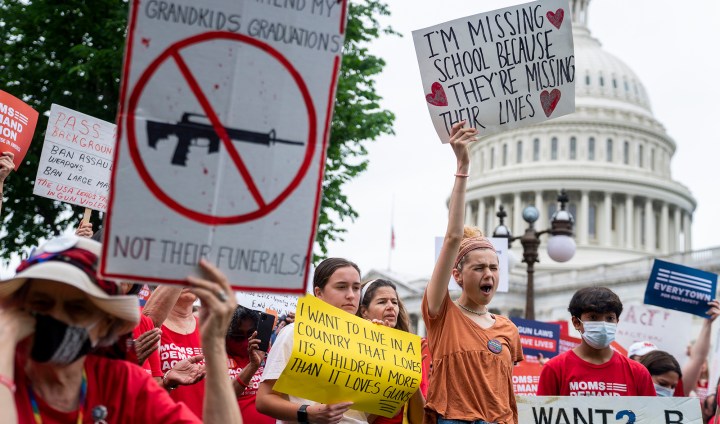
There are sacrifices that richly deserve honour and respect, such as those who fall in the defence of their nation. But there are also sacrifices that come about because of the ownership and employment of military-style weapons used on innocent children and shoppers.
Monday 30 May was Memorial Day in America. Each year, that day memorialises those in the country’s military who made the ultimate sacrifice. This annual commemoration began in 1868, shortly after the end of the American Civil War, a response to the horrific losses of those who served in the military in that war.
More than a century and half later, several places in the nation claim to be the original home of the commemoration. These include Arlington National Cemetery located just across the Potomac River from the nation’s capital; the town of Waterloo in upstate New York, and Boalsburg, Pennsylvania, located in the centre of that state. Those, and others like them, were set to honour the sacrifices of Union soldiers and sailors to preserve the nation.
With the passage of time, the day has also now become the unofficial beginning of the summer vacation season in America.
But if one goes to small towns across the country, there are parades and ceremonies marking the day’s original meaning. Around 30 years ago, we attended the events in Boalsburg, and it almost felt like we were stepping into a Norman Rockwell painting.
In the march past, there were Boy Scout troops, volunteer fire department detachments, high school marching bands and vendors along the main street selling T-shirts with patriotic messages, as well as cool drinks, hot dogs and hamburgers. And, of course, there was a cohort of veterans marching, including now-aged veterans from World War 2, with some in wheelchairs who had been wounded in battle or just suffering the ravages of age.
The day was both solemn and joyous, with an unspoken but obvious theme: “Thanks for your service — and the sacrifices you and so many others made on behalf of the nation.”
Dancing to a different tune
This past weekend, my wife and I attended the extraordinary performance of a dance work in downtown Johannesburg, at the Dance Factory.
Entitled “The Sacrifice”, it was choreographed by Dada Masilo, who also danced the lead role. It was, she has said, loosely but magnificently inspired by the storyline for Igor Stravinsky’s ballet score, “The Rite of Spring”, which had first been choreographed by Sergei Diaghilev for the Ballet Russe back in 1913.
For many, this work is one of the key moments at the beginning of the modern era in classical music and, as the story goes, had sparked a near riot at its premiere in 1913 in Paris. Chairs were thrown.
In her own new work, Masilo’s character is a young woman in a presumably Tswana-inflected village who goes through life’s cyclical, rural rituals of planting and harvesting, until she becomes a sacrificial victim to save the village from some kind of plague (or perhaps she has been the fatal victim of gender-based violence).
As she passes away, the final moments are performed to the deeply mournful yet calming sounds of Ana Masina’s astonishing contralto voice.
Masilo’s character’s sacrifice occupies a complex, even ambivalent space between a more purposeful (albeit horrific) death and a dreadfully meaningless one.
As a backstory for the work, it had been in development from just before the beginning of the Covid pandemic. As a result, though, it also became an artistic sacrifice, kept in limbo for many months before being performed recently in festivals in Europe.
This was its first time as a completed work being performed in Johannesburg, just prior to the company’s return to more European cultural festival performances.
Mass shootings
For this writer, these discourses on sacrifice became a backdrop for events in the United States that seem to have become almost routine, but horrific, events in the tapestry of American life.
I am referring, obviously, to that recurring tragedy, seemingly without end, of mass shootings in shopping malls, churches, synagogues, nightclubs — and elementary schools.
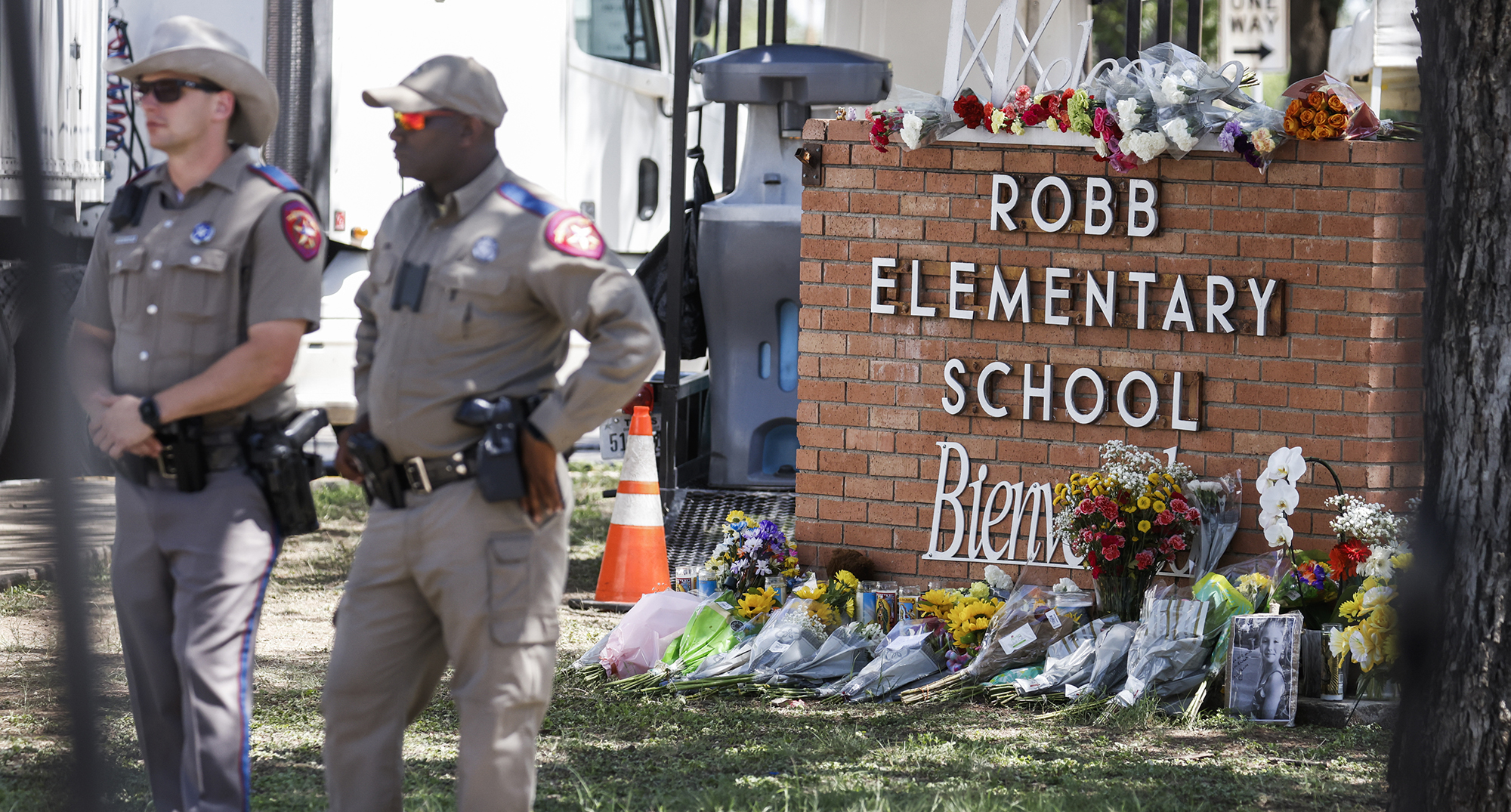
Texas Highway Patrol officers stand near a memorial of flowers at the scene of a mass shooting at the Robb Elementary School in Uvalde, Texas, USA, 25 May 2022. According to Texas officials, at least 19 children and two adults were killed in the shooting. The eighteen-year-old gunman was killed by responding officers. (Photo: EPA-EFE/Tannen Maury)
Such tragedies create a growing crop of innocent sacrificial victims on the altar of senseless mass shooter violence.
Attempting to make some kind of sense out of an inexplicable stream of victims, New York Times columnist Maureen Dowd (coming from a long family line of police) tried to come to grips with the nature of such sacrifices. Dowd reached back to Shakespeare and ancient Greek tales, writing, “Once, when I thought of child sacrifice, I thought of ancient shibboleths.
“In Aeschylus, Agamemnon lures his daughter, Iphigenia, to a spot she thinks is for her wedding, as the chorus urges: ‘Hoist her over the altar like a yearling, give it all your strength… gag her hard.’ Agamemnon agonised but felt he had to sacrifice his daughter to appease a goddess and be granted favourable winds to sail against Troy. Small sacrifice to get your fleet moving.
“In Shakespeare, Titus Andronicus kills his daughter, Lavinia, at the dinner table, after she has been raped and maimed by attackers. ‘Die, die, Lavinia!’ he cries. ‘And thy shame with thee.’ Small sacrifice to save your honour.
“On Game of Thrones, Stannis Baratheon orders his sweet child Shireen burned at the stake, as she cries out for the father she adores, so black magic will melt the snow. Small sacrifice to get your starving army on the march.
“Now, however, I think of child sacrifice as a modern phenomenon, a barbaric one that defines this country. We are sacrificing children, not only the ones who die, but also those who watch and those who fear the future,” wrote Dowd.
In her search for a mooring, she might easily have added the biblical drama of Abraham and Isaac. The patriarch had listened to a voice in his head who had told him to kill his son in order to prove his loyalty to his god. Providentially, he is miraculously offered a ram entangled in a thorn bush as the preferred alternative to his own child. (The children and teachers in Uvalde and Sandy Hook, the shoppers in Buffalo, and all the others did not have such a sudden deliverance.)
If Abraham’s would-have-been sacrifice was about religious piety and obedience to faith, what we see now are sacrifices for no other purpose than an insistence by a coven of mendacious politicians and not a few judges, the National Rifle Association and kindred organisations and weapons makers, and a cohort of American gun-owning Kool-Aid drinkers all prepared to argue this mountain of sacrifices is necessary to honour an ahistorical reading of one short clause in the US Constitution.
The full text of that Second Amendment to the Constitution reads: “A well regulated Militia being necessary to the security of a free State, the right of the people to keep and bear Arms shall not be infringed.”
The founding father-writers of that amendment had just emerged from nearly a decade-long struggle to free their 13 colonies from British rule. And the leaders in some of the newly independent colonies-turned-states actually refused to sign on to the new constitution in the absence of enumerated rights enshrined in the foundational document.
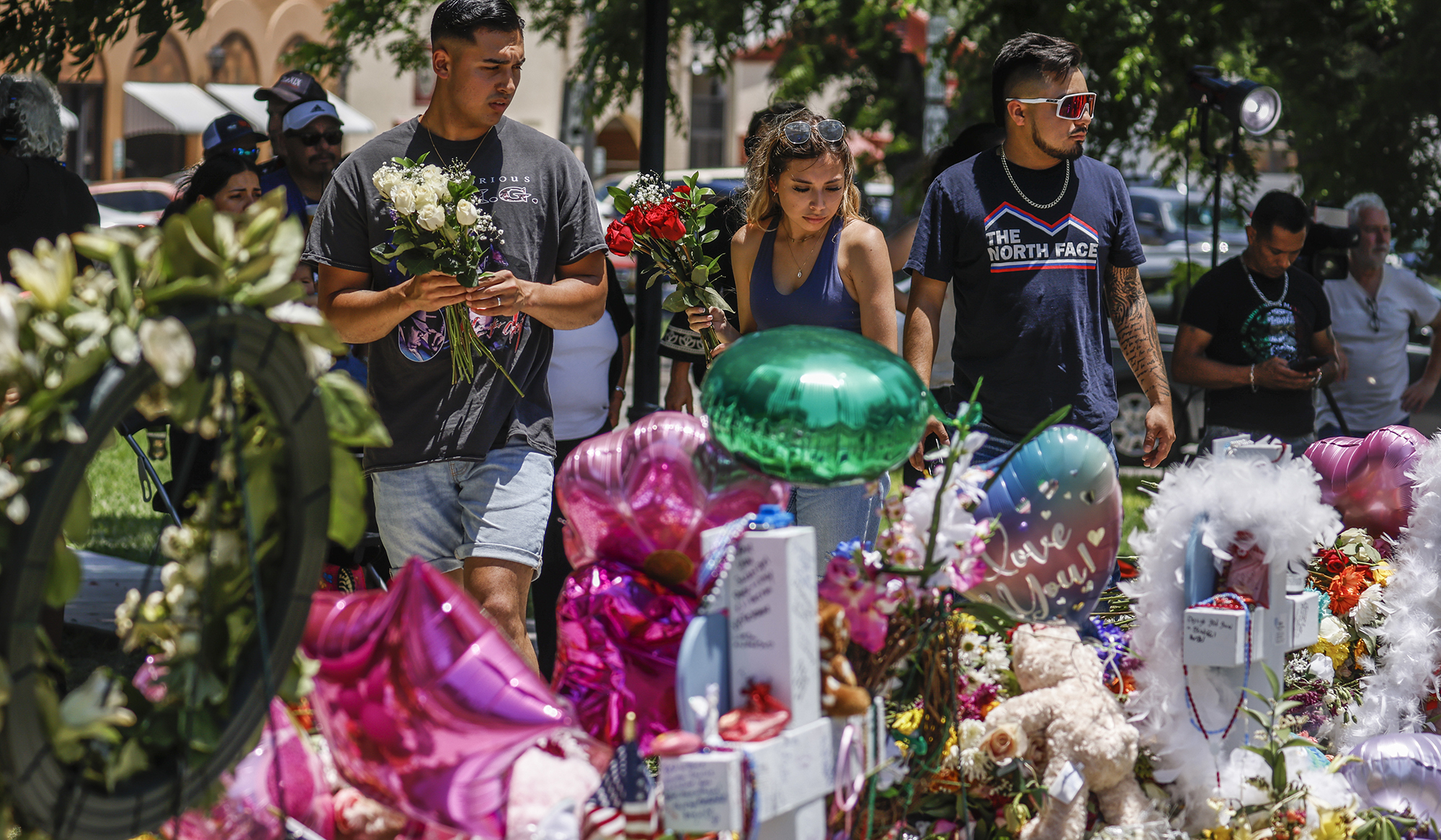
People continue to pay respect to the victims at the Uvalde town square memorial following the shooting at Robb Elementary School in Uvalde, Texas, USA, 29 May 2022. According to Texas officials, at least 19 children and two adults were killed in the shooting on 24 May. The eighteen-year-old gunman was killed by responding officers. (Photo: EPA-EFE/Tannen Maury)
Freedoms worth protecting
Freedom of the press, speech, assembly and the free exercise of religion were and remain obvious ideas worth protecting, along with speedy trials. But this bit about the right to keep and bear arms has a more complex origin story that its current devotees are prepared to recognise.
Back then, the colonial militias had been instrumental in the victory over Britain, and this particular right had been written to ensure the tyranny and depredations of a national army would not be inflicted upon the defenceless populations of the respective states. Accordingly, citizens were guaranteed the right to join their state’s “well-regulated” militia.
Those state militias have evolved over time into the National Guard, and those forces are now integrated into the overall command structures of the US military whenever they are summoned to active military duty, unless they are dealing with a natural disaster such as a hurricane, or civil disturbances beyond the ability of local police forces to contain.
But, under pressure from gun owners and their associations in court battles, successive courts have elided around that obvious qualifying phrase and produced legal interpretations of the notion “shall not be infringed” as applying virtually universally to anyone with a hand-held weapon.
Still, since it is true federal regulations (and court rulings) that preclude individuals from owning tanks, F-16 fighter jets or a cruise missile launching rack, a regulatory framework for some weapons ownership does exist and has been accepted by the courts.
A federal ban on assault-style long guns was also passed into law some years ago, but it had an expiry date, and when that date was reached it was not renewed, under pressure from the gun lobby.
Within this larger picture, it is also true that some individual states have laws regarding age restrictions over the right to own firearms (as in restrictions on anyone purchasing weapons under the age of 21).
Still, requirements requiring uniform background checks for criminal or psychological conditions, or restrictions on ownership of assault rifles, are not uniform across the nation.
A young man could, conceivably, purchase a long gun or semi-automatic assault weapon in a more lightly regulated state and transport it to another state and use it there to shoot people, as readers may recall from what happened at a demonstration in Kenosha, Wisconsin, last year.
Gun control
In recent years, some states such as Texas have loosened restrictions on who can purchase a weapon, and whether they can be carried on their person pretty much anywhere they want throughout the state. Ironically, no individuals could bring their weapons into the National Rifle Association annual convention in Houston, Texas, that took place just days after the slaughter in Uvalde — no guns were allowed on the convention floor.
That would have been too dangerous, perhaps, for the officers of the NRA and their rabble-rousing guest speakers such as the former president. The Texas governor at least had the decency to deliver his address by video link and pay his respects to the victims in Uvalde instead, but he made no offers of any future restrictions on gun ownership.
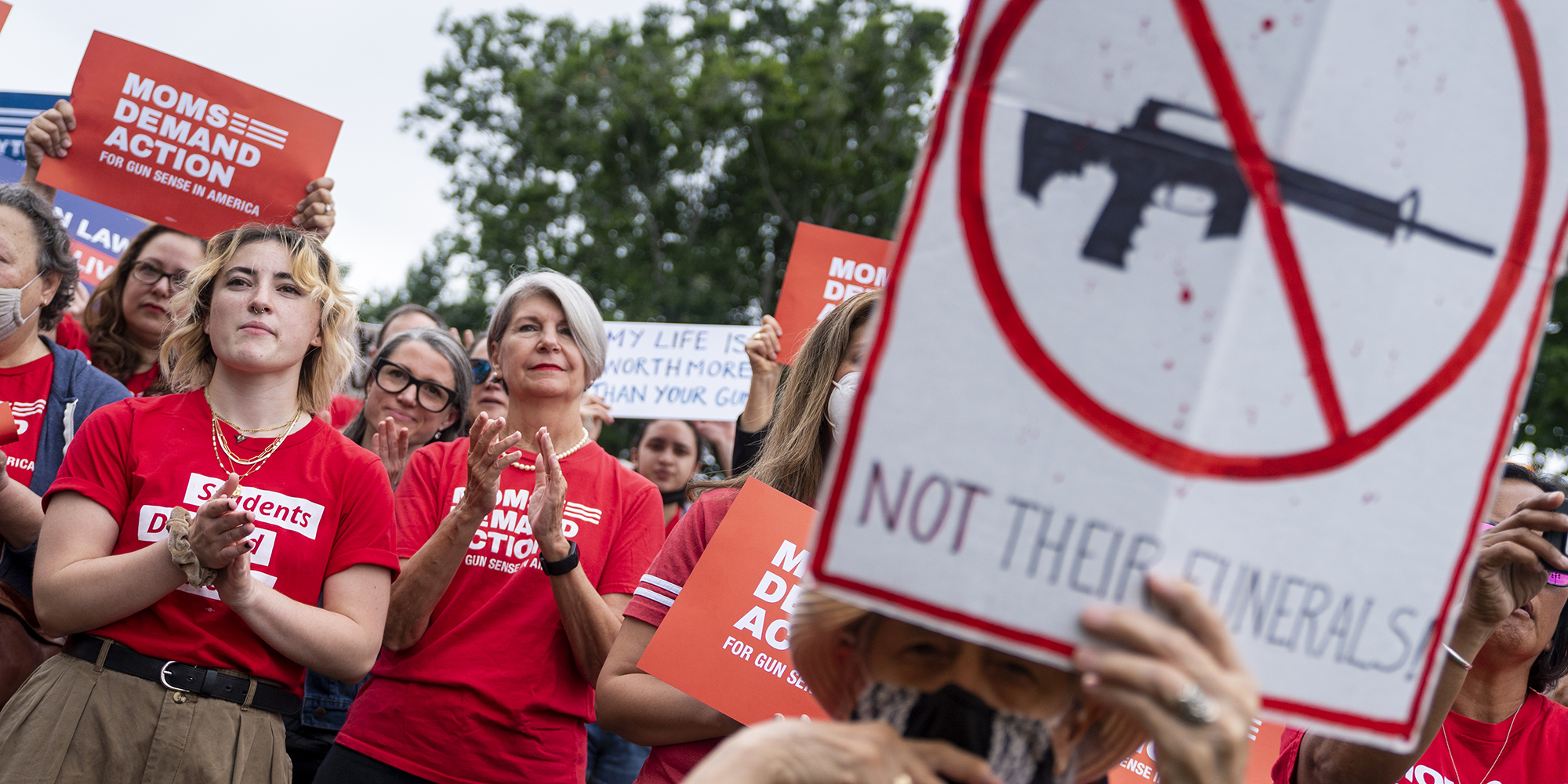
Activists rally demanding action on gun safety laws outside the US Capitol in Washington, DC, USA 26 May 2022. Activists gathered in the wake of the mass shooting at Robb Elementary in Uvalde, Texas and are demanding action on gun safety legislation. (Photo: EPA-EFE/Shawn Thew / Pool)
The history of gun ownership in America means there are somewhere between 300 to 400 million firearms in private hands in the nation, with about four in 10 Americans in a home where there are guns, and around three in 10 saying they own one themselves, per the Pew Research Centre. (No one is seriously trying to propose a mandatory surrender of guns already in circulation in America, as has been carried out in several other nations.)
The problem with gun control is more than simply regulating new sales.
Making things more difficult, still, are so-called private sales at gun shows (somewhat like a swap meet married to a jumble sale, but run as a for-profit business in a hall somewhere where the only items for sale are those designed to kill), as well as sales of ghost guns.
Ghost guns are not-yet-functioning weapons sold as kits — until they are assembled by the buyer. They are something like a kit for a famous model ship, except that a 1:500 scale model of the Bismarck is unlikely to be used to kill someone.
And then, of course, there are also all the guns in circulation in the hands of would-be criminals and former criminals. This has added to concerns by some police forces that they might conceivably be outgunned by malefactors in any street battle. The police are not the hardcore supporters of an unfettered right to own guns without restrictions.
Pew also reports, “In a Gallup survey conducted in August 2019, gun owners were most likely to cite personal safety or protection as the reason they own a firearm.
“Roughly six-in-10 (63%) said this in an open-ended question. Considerably smaller shares gave other reasons, including hunting (40%), nonspecific recreation or sport (11%), that their gun was an antique or a family heirloom (6%) or that the gun was related to their line of work (5%).”
The Pew data also adds that around half of Americans (48%) see gun violence as a very big problem in the country today, although “attitudes about gun violence differ widely by race, ethnicity, party and community type.
About eight-in-10 black adults (82%) say gun violence is a very big problem — by far the largest share of any racial or ethnic group. By comparison, about six-in-ten Hispanic adults (58%) and 39% of white adults view gun violence this way.”
Moreover, “Democrats and Democratic-leaning independents are far more likely than Republicans and GOP leaners to see gun violence as a major problem (73% vs 18%).
“And nearly two-thirds of Americans who describe their community as urban (65%) say the same, compared with 47% of suburbanites and 35% of those who live in rural areas.”
Also according to Pew, a little over half of Americans (53%) favour stricter gun laws. While that number was slightly lower than in years before that data was collected, it seems likely following the recent Buffalo and Uvalde killings, among other calamities, if the survey were carried out today, the percentage of those who support stricter gun laws would likely be higher.
For the love of guns
Aside from that notably problematic interpretation of the Second Amendment on the part of gun manufacturer lobbyists, gun owners, the NRA, various politicians, and a number of judges, what lies at the heart of this love of firearms?
Is it some kind of unique delusion among Americans? To be fair, mass murders by deadly weapons-wielding people have not been limited to America. Britain, Australia, New Zealand, Norway and even Canada have had their encounters with this too.
And South Africa has also had a problem with firearms in the hands of people who have had a willingness to use them on innocent bystanders, as well as the nation’s ongoing wave of political killings, although not in murderous rampages such as those in Uvalde, Texas, Buffalo, New York, or Sandy Hook, Connecticut.
But what seems largely to be missing in those other nations is the American near-mythic love for the very idea of firearms, such as the mystique of the frontier and the place of firearms in that mystique.
There stands an iconic American, facing fierce, wild animals; the need to hunt for the table; and the need to hold off the depredations of the indigenes or the former British colonial master. Collectively these have powered the idea that a well-made long rifle or two is the ultimate equaliser.
Similarly, there is also the idea of the man with his weapons, holding at bay the bad guys (think in cinematic imagery of such mythic heroes as Shane or Marshall Will Kane in “High Noon”) as the hero and his family only wish to live their lives undisturbed by criminals.
But now, increasingly, there is the sense — as a perverse echo of the original impetus behind the Second Amendment — that gun ownership is, ultimately, the only way the ordinary man can hold off the depredations of his government, an entity that is apparently eager to destroy the country as it traduces the rights of free men, and then seize his property.
As his comments were reported in the Washington Post, “On Fox News Sunday, Rep. Mo Brooks (R-Ala.), who is running for Senate, indicated he would not support any changes to gun laws currently on the books, saying ‘un-infringed Second Amendment rights’ were required in case citizenry needed to ‘take our government back.’”
Representative Brooks is a particularly retrograde version of the political species, but his impulse is alive among other Republicans — paralleling the hatred and fear of other subversive ideas such as reproductive rights, gay rights or Critical Race Theory.
Now, stir in the contemporary link between the NRA plus the more belligerent National Association for Gun Rights, a dose of politicians, other special interest groups and voters who have a nearly monomaniacal fixation on fighting off any possible advances in firearms regulation, and the locus of anti-gun control political power comes visible.
The NRA
The NRA is an interesting phenomenon. Over a hundred years ago it came into being as a body interested in gun safety and training, with one of its goals to ensure young men who might enter future military service had the necessary grounding in safe weapons handling.
For years, it was largely non-partisan, but from the 1950s onward, it began to change its spots, partly in response to the growing rightward slide of the Republican Party at the national level and the political leverage that might imply.
The NRA, now, is however fighting off lawsuits and investigations into its financing and may be weaker than it has ever been.
Combined with anger over the most recent mass killings, it is just possible there may be some modest action on gun ownership regulation at the national level, or at least in various states.
As the Washington Post 202 daily newsletter reported, Democrats finally may be able to push through confirmation of the president’s candidate to be director of the Bureau of Alcohol, Tobacco and Firearms — a position unfilled for years.
This office is responsible for enforcing existing gun laws and prosecuting illicit activity, including gun trafficking. A permanent head would also be able to carry out desperately needed information management updates to shift from cartons of virtually unsearchable paper records to a digital system.
Meanwhile, Connecticut Democratic Senator Chris Murphy has been trying to build a coalition with several moderate Republicans who could support at least some gun controls that could make it harder for individuals to carry out the kinds of mass shootings such as the most recent ones.
Background checks
If public opinion is any guide, such legal changes should include a background check national clearance process to eliminate felons from purchasing weapons, a uniform red-flagging system to eliminate individuals with demonstrated psychological issues, a minimum age barrier of 21 before they are allowed to purchase weapons, proper record-keeping of gun show sales and ghost kit sales, and strict restrictions on the sale of semi-automatic assault weapons and protective body armour.
But even these limited measures are likely to run into a buzzsaw of Republican opposition in the Senate, as well as fierce lobbying in the House by organisations like the NRA who will argue such a package is the first step towards abolishing the right to bear arms.
Not even on the table right now is a roster of regulations equivalent to those that apply when someone wants a driver’s licence, wants to purchase and register a car, and then plans to drive it without being intoxicated behind the wheel.
As things stand now, though, a person becoming a dental hygienist or barber probably has more regulatory hoops to jump through than a Texan teenager buying an assault rifle. DM
[hearken id=”daily-maverick/9588″]







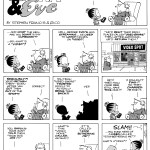












 Become an Insider
Become an Insider
Comments - Please login in order to comment.